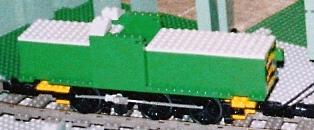Subject:
|
Re: New MOC: Prototype Class 14 Diesel Loco with BBB Wheels
|
Newsgroups:
|
lugnet.trains
|
Date:
|
Mon, 28 Mar 2005 16:38:43 GMT
|
Viewed:
|
3909 times
|
| |

|
|
In lugnet.trains, Ross Crawford wrote:
| |
In lugnet.trains, Mark Bellis wrote:
| |
Here’s a new train MOC, a prototype Class 14 diesel loco.

|
Very nice!
| |
It uses BBB wheels and is articulated to get round the curves.
It uses 2 technic gearmotors for power, so it has an electric feed from an
adjacent vehicle with a train motor (not yet constructed).
|
From my experience, the hardest part of doing that is matching the speed of
the supply car. I actually ended up putting a rubber band drive in my loco to
allow some slip, and gearing so it was faster than the train motor. The
technic motors seem to run a lot slower with the train motor in parallel, I
guess they’re less efficient. I was thinking about removing the train motor
altogether and just using it for power pickup, but never got around to it.
|
I found that at low power levels of RCX drive, a technic motor in parallel
actually caused the train motor to speed up - the technic motor must provide
some filtering of the PWM.
I already have other engines using gearmotors, so I used similar ratios, though
as you say I geared the BBB wheels a bit faster than the train motor. This
engine won’t be doing full speed anyway - its maximum design speed is 40mph, 2nd
notch on a 9V controller.
| |
| |
Pictures of the real loco can be seen here:
http://www.preserved-diesels.co.uk/engines/14/index.htm
I used cams for the counterweights on the jackshaft (the shaft from the
engine that moves the rods to drive the wheels). There are two ‘bogies’ -
one with four wheels and the other with two wheels and the jackshaft.
|
Is the jackshaft geared to the wheels, or just relies on the rods to turn it?
ROSCO
|
On the real thing, the jackshaft drives the rods in order to drive the wheels,
but on my model it’s different. The underneath view
http://www.brickshelf.com/cgi-bin/gallery.cgi?i=1150094 shows that there is a
4x4 turntable above each end pair of wheels. There are two bogies, one with
four wheels and the other with two wheels and the jackshaft. A link in the
middle keeps them together. The drive is via bevel gears to the two end sets of
wheels and the rods do the rest.
Two gearmotors are required, in order for the loco to have enough torque at that
speed to pull its own weight rather than being pushed by the vehicle that will
contain the train motors. The axles going down through the turntables cause a
lot of friction, but it is essential to keep the wheels synchronised.
The flex system rods extend and contract between the two bogies. This technique
might be useful for people who don’t want to use blind drivers if the engine
wheelbase is too long for the curves.
Mark
|
|
Message is in Reply To:
 | | Re: New MOC: Prototype Class 14 Diesel Loco with BBB Wheels
|
| (...) Very nice! (...) From my experience, the hardest part of doing that is matching the speed of the supply car. I actually ended up putting a rubber band drive in my loco to allow some slip, and gearing so it was faster than the train motor. The (...) (21 years ago, 27-Mar-05, to lugnet.trains, FTX)
|
3 Messages in This Thread:
    
- Entire Thread on One Page:
- Nested:
All | Brief | Compact | Dots
Linear:
All | Brief | Compact
|
|
|
|